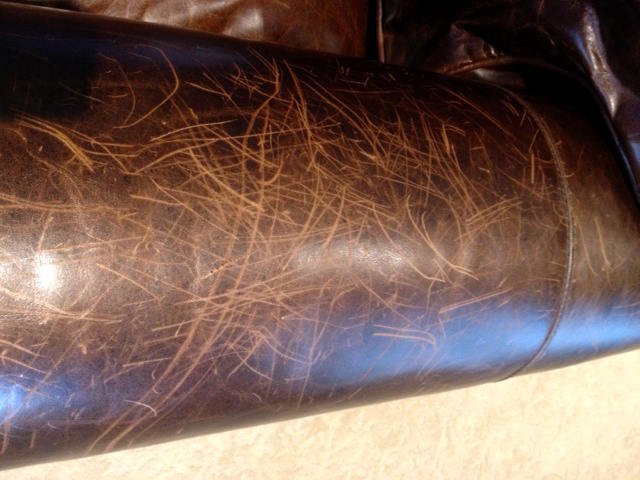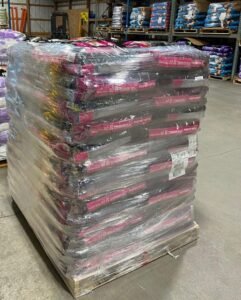How to Repair Dog Scratches on Leather Couch. To repair dog scratches on a leather couch, clean the area with a soft cloth and leather cleaner. Then, use a leather repair kit to fill in the scratches.
Dogs bring joy but can also leave their mark on furniture. Leather couches, while durable, are not immune to scratches from playful pets. These scratches can be unsightly, affecting the overall appearance of your living space. Fortunately, repairing these blemishes is often straightforward and requires minimal supplies.
By addressing the scratches promptly, you can restore your couch’s original look and prolong its lifespan. This guide will provide step-by-step instructions to effectively repair those pesky dog scratches, ensuring your leather couch remains beautiful and functional for years to come. Embrace your pet’s playful spirit without compromising your home decor!

Credit: m.youtube.com
Table of Contents
Introduction To Leather Couch Repair
Leather couches bring elegance to any room. They can, however, suffer scratches from pets. Repairing these scratches is crucial for maintaining their beauty. This guide will help you understand the basics of leather couch repair.
Initial Assessment
Before starting repairs, assess the damage. Follow these steps:
- Identify the type of leather. Different leathers need different care.
- Check the depth of the scratches. Are they surface-level or deeper?
- Look for any discoloration. This may need special attention.
Taking notes on the damage will help in the repair process.
Tools And Materials Needed
Gather the right tools and materials. This will make the repair easier. Here’s a list:
| Tools | Materials |
|---|---|
| Soft cloth | Leather conditioner |
| Leather repair kit | Color match dye |
| Scissors | Leather glue |
| Sandpaper | Rubbing alcohol |
Having these items ready will streamline your repair process.
Identifying The Type Of Leather
Knowing your leather type helps choose the right repair method. Different leathers react differently to scratches. Identifying the type is key to effective repair.
Differentiating Between Real And Faux Leather
Real leather and faux leather look similar but differ in composition. Here’s how to tell them apart:
| Feature | Real Leather | Faux Leather |
|---|---|---|
| Texture | Soft and natural feel | Smooth and sometimes plastic-like |
| Smell | Has a distinct leather smell | No leather scent |
| Price | Usually more expensive | Generally cheaper |
| Durability | Long-lasting | Less durable than real leather |
- Check the texture with your hand.
- Smell the material for a leather scent.
- Inspect the price; real leather costs more.
Impact Of Leather Type On Repair Methods
Different leathers require different care. Here’s how the type affects repairs:
- Real Leather: Use leather conditioner and specific repair kits.
- Faux Leather: Use vinyl repair products or fabric patches.
Always test products on a hidden area first. This prevents damage to the visible parts. Each type has its strengths and weaknesses. Understanding these helps you choose wisely.
Pre-cleaning The Affected Area
Cleaning the area before repairs is vital. It ensures that dirt and oils do not interfere with the repair process. A clean surface allows for better adhesion of products used for fixing scratches.
Why Cleaning Is Crucial
Cleaning is important for several reasons:
- Removes debris: Dirt can worsen scratches.
- Prevents further damage: Oils can weaken leather.
- Enhances repair quality: Clean surfaces bond better.
Recommended Cleaning Solutions
Choose the right cleaning solution for your leather couch. Here are some effective options:
| Product | Benefits |
|---|---|
| Water and mild soap | Safe for most leather types. |
| Leather cleaner | Specially designed for leather care. |
| White vinegar | Natural option for stains. |
Always test any solution on a hidden area first. This prevents unexpected discoloration or damage.
Follow these steps to clean the affected area:
- Mix your chosen cleaning solution.
- Dampen a soft cloth with the solution.
- Gently wipe the scratched area.
- Let it dry completely.
After cleaning, you are ready to repair the scratches on your leather couch.
Minor Scratch Repair Techniques
Dog scratches on leather couches can be frustrating. Luckily, minor scratches can be fixed easily. Use simple techniques to restore your couch’s beauty.
Using Olive Oil
Olive oil is a natural and effective remedy. It helps in moisturizing the leather. Follow these steps:
- Gather your materials: olive oil and a soft cloth.
- Put a small amount of olive oil on the cloth.
- Gently rub the oil onto the scratched area.
- Use circular motions for even coverage.
- Let it sit for 15 minutes.
- Wipe off excess oil with a clean cloth.
This method can enhance the leather’s appearance. It can also prevent future scratches.
Applying Leather Conditioner
A leather conditioner is essential for maintaining your couch. It restores moisture and flexibility. Here’s how to apply it:
- Choose a high-quality leather conditioner.
- Clean the scratched area with a damp cloth.
- Apply a small amount of conditioner to a soft cloth.
- Rub the conditioner into the scratch gently.
- Allow the conditioner to absorb for at least 30 minutes.
- Buff the area with a dry cloth.
Regular conditioning keeps the leather supple. This reduces the chances of future scratches.
| Technique | Materials Needed | Time Required |
|---|---|---|
| Using Olive Oil | Olive oil, soft cloth | 15 minutes |
| Applying Leather Conditioner | Leather conditioner, damp cloth, soft cloth | 30 minutes |
These techniques are simple yet effective. They can help restore your leather couch.
Fixing Deeper Scratches
Deeper scratches on leather couches require careful attention. These scratches can ruin the look of your furniture. Follow these steps to restore your couch’s beauty.
Leather Filler Application
Begin by cleaning the scratched area with a damp cloth. Allow it to dry completely. Then, use a leather filler to repair the damage. Here’s how:
- Choose a high-quality leather filler.
- Apply the filler with a plastic spatula.
- Fill the scratch completely, smoothing it out.
- Let it dry for at least 30 minutes.
Check the filler after drying. If it looks uneven, apply more filler.
Sanding The Area
Once the filler is dry, gently sand the area. This helps blend the repair with the surrounding leather. Follow these steps:
- Use fine-grit sandpaper, around 400-grit.
- Sand lightly to avoid damaging the leather.
- Check frequently to ensure a smooth surface.
After sanding, wipe away any dust with a clean cloth.
Color Matching And Dye Application
After sanding, it’s time to match the color. This ensures the repair blends well. Follow these steps:
- Select a leather dye that matches your couch.
- Apply the dye with a soft cloth or sponge.
- Use thin layers to build up color gradually.
- Allow it to dry completely before adding more layers.
Check the color after each layer. Adjust until it matches perfectly.

Credit: rubnrestore.com
Professional Repair Options
Professional repair options can restore your leather couch’s beauty. Skilled technicians handle scratches expertly. They use special tools and techniques. This ensures high-quality results.
When To Seek Professional Help
Consider professional help in these situations:
- Deep scratches that penetrate the leather.
- Multiple scratches or extensive damage.
- Damage from pet urine or other stains.
- When DIY methods fail to work.
Professionals provide a thorough assessment. They can match the leather color perfectly. This helps maintain your couch’s appearance.
Estimated Costs
The cost of professional repairs varies. Here’s a simple table to guide you:
| Type of Repair | Estimated Cost |
|---|---|
| Minor Scratch Repair | $50 – $100 |
| Moderate Damage Repair | $100 – $200 |
| Severe Damage Repair | $200 – $500 |
Costs depend on several factors:
- Extent of the damage.
- Type of leather.
- Location of the repair service.
Request quotes from different professionals. Compare prices and services offered. Make an informed decision for your couch.
Preventive Measures
Taking preventive measures can help protect your leather couch from dog scratches. Regular care and the right products keep your furniture in great shape. Here are effective tips to consider.
Regular Maintenance Tips
- Clean regularly: Use a soft, dry cloth to wipe dust.
- Condition leather: Apply a leather conditioner every 3-6 months.
- Check for wear: Inspect your couch for scratches or damage often.
- Keep nails trimmed: Regularly trim your dog’s nails to minimize scratches.
Protective Products To Consider
| Product | Description | Benefits |
|---|---|---|
| Leather Conditioner | Moisturizes and protects leather. | Prevents cracking and fading. |
| Protective Cover | A removable cover for your couch. | Offers an extra layer against scratches. |
| Scratch Remover | A special solution for scratches. | Helps restore the leather’s appearance. |
Investing in these products can save your couch. Protecting it now will pay off in the long run.

Credit: www.reddit.com
Frequently Asked Questions
How Can I Hide Dog Scratches On Leather?
You can hide dog scratches using a leather conditioner or a leather repair kit. These products fill in scratches and restore the color. For minor scratches, gently rub the area with a soft cloth. Always test on a small, inconspicuous area first to ensure compatibility.
What Products Are Best For Repairing Leather Scratches?
Look for specialized leather repair kits, which often include color-matching compounds. Leather conditioners can also help blend scratches. Brands like Fiebing’s and Leather Honey are popular choices. Always read the instructions carefully to ensure the best results for your leather couch.
Can I Use Household Items To Fix Scratches?
Yes, some household items can help. Olive oil and vinegar can work for small scratches. Apply a small amount and buff gently. However, always perform a patch test first to avoid damaging your leather couch further.
How Do I Prevent Future Dog Scratches On Leather?
To prevent future scratches, train your dog to avoid jumping on the couch. Use furniture covers or throws to protect the leather. Regular grooming can also reduce claw damage. Consider providing designated areas for your dog to play and relax.
Conclusion
Repairing dog scratches on your leather couch is manageable with the right approach. By using simple techniques, you can restore your furniture’s beauty. Regular maintenance will prevent future damage. Enjoy a scratch-free couch while keeping your furry friend happy. Follow these tips to maintain your leather furniture for years to come.



